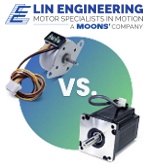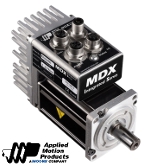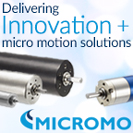 |
| August 21, 2018 | Volume 14 Issue 31 |
Motion Control News & Products
Designfax weekly eMagazine
Archives
Partners
Manufacturing Center
Product Spotlight
Modern Applications News
Metalworking Ideas For
Today's Job Shops
Tooling and Production
Strategies for large
metalworking plants
Choosing a stepper motor: PM or hybrid?
 Lin Engineering stepper motors are widely used in various applications that require precise control of motion, such as in robotics, 3D printing, CNC machines, and medical equipment. There are two main types of stepper motors: permanent magnet (PM) and hybrid. Learn the differences, advantages, and when to use one type or the other.
Lin Engineering stepper motors are widely used in various applications that require precise control of motion, such as in robotics, 3D printing, CNC machines, and medical equipment. There are two main types of stepper motors: permanent magnet (PM) and hybrid. Learn the differences, advantages, and when to use one type or the other.
Read this informative Lin Engineering article.
Top Product: Integrated servo system is 20% smaller than standalone unit
 Applied Motion Products has introduced the MDX+ series, a family of low-voltage servo systems that integrate a servo drive, motor, and encoder into one package. This all-in-one drive unit is an ideal solution for manufacturers in logistics, AGV, medical, semiconductor, the solar industries, and many others.
Applied Motion Products has introduced the MDX+ series, a family of low-voltage servo systems that integrate a servo drive, motor, and encoder into one package. This all-in-one drive unit is an ideal solution for manufacturers in logistics, AGV, medical, semiconductor, the solar industries, and many others.
Read the full article.
Overhung load adaptors provide load support and contamination protection
 Overhung load adaptors (OHLA) provide both overhung radial and axial load support to protect electrified mobile equipment motors from heavy application loads, extending the lifetime of the motor and alleviating the cost of downtime both from maintenance costs and loss of production. They seal out dirt, grime, and other contaminants too. Zero-Max OHLAs are available in an extensive offering of standard models (including Extra-Duty options) for typical applications or customized designs.
Overhung load adaptors (OHLA) provide both overhung radial and axial load support to protect electrified mobile equipment motors from heavy application loads, extending the lifetime of the motor and alleviating the cost of downtime both from maintenance costs and loss of production. They seal out dirt, grime, and other contaminants too. Zero-Max OHLAs are available in an extensive offering of standard models (including Extra-Duty options) for typical applications or customized designs.
Learn more.
Why choose electric for linear actuators?
 Tolomatic has been delivering a new type of linear motion technology that is giving hydraulics a run for its money. Learn the benefits of electric linear motion systems, the iceberg principle showing total cost of ownership, critical parameters of sizing, and conversion tips.
Tolomatic has been delivering a new type of linear motion technology that is giving hydraulics a run for its money. Learn the benefits of electric linear motion systems, the iceberg principle showing total cost of ownership, critical parameters of sizing, and conversion tips.
Get this informative e-book. (No registration required)
New AC hypoid inverter-duty gearmotors
 Bodine Electric Company introduces 12 new AC inverter-duty hypoid hollow shaft gearmotors. These type 42R-25H2 and 42R-30H3 drives combine an all-new AC inverter-duty, 230/460-VAC motor with two hypoid gearheads. When used with an AC inverter (VFD) control, these units deliver maintenance-free and reliable high-torque output. They are ideal for conveyors, gates, packaging, and other industrial automation equipment that demands both high torque and low power consumption from the driving gearmotor.
Bodine Electric Company introduces 12 new AC inverter-duty hypoid hollow shaft gearmotors. These type 42R-25H2 and 42R-30H3 drives combine an all-new AC inverter-duty, 230/460-VAC motor with two hypoid gearheads. When used with an AC inverter (VFD) control, these units deliver maintenance-free and reliable high-torque output. They are ideal for conveyors, gates, packaging, and other industrial automation equipment that demands both high torque and low power consumption from the driving gearmotor.
Learn more.
Next-gen warehouse automation: Siemens, Universal Robots, and Zivid partner up
 Universal Robots, Siemens, and Zivid have created a new solution combining UR's cobot arms with Siemens' SIMATIC Robot Pick AI software and Zivid's 3D sensors to create a deep-learning picking solution for warehouse automation and intra-logistics fulfillment. It works regardless of object shape, size, opacity, or transparency and is a significant leap in solving the complex challenges faced by the logistics and e-commerce sectors.
Universal Robots, Siemens, and Zivid have created a new solution combining UR's cobot arms with Siemens' SIMATIC Robot Pick AI software and Zivid's 3D sensors to create a deep-learning picking solution for warehouse automation and intra-logistics fulfillment. It works regardless of object shape, size, opacity, or transparency and is a significant leap in solving the complex challenges faced by the logistics and e-commerce sectors.
Read the full article.
Innovative DuoDrive gear and motor unit is UL/CSA certified
 The DuoDrive integrated gear unit and motor from NORD DRIVE-SYSTEMS is a compact, high-efficiency
solution engineered for users in the fields of intralogistics, pharmaceutical, and the food and beverage industries. This drive combines a IE5+ synchronous motor and single-stage helical gear unit into one compact housing with a smooth, easy-to-clean surface. It has a system efficiency up to 92% and is available in two case sizes with a power range of 0.5 to 4.0 hp.
The DuoDrive integrated gear unit and motor from NORD DRIVE-SYSTEMS is a compact, high-efficiency
solution engineered for users in the fields of intralogistics, pharmaceutical, and the food and beverage industries. This drive combines a IE5+ synchronous motor and single-stage helical gear unit into one compact housing with a smooth, easy-to-clean surface. It has a system efficiency up to 92% and is available in two case sizes with a power range of 0.5 to 4.0 hp.
Learn more.
BLDC flat motor with high output torque and speed reduction
 Portescap's 60ECF brushless DC slotted flat motor is the newest frame size to join its flat motor portfolio. This 60-mm BLDC motor features a 38.2-mm body length and an outer-rotor slotted configuration with an open-body design, allowing it to deliver improved heat management in a compact package. Combined with Portescap gearheads, it delivers extremely high output torque and speed reduction. Available in both sensored and sensorless options. A great choice for applications such as electric grippers and exoskeletons, eVTOLs, and surgical robots.
Portescap's 60ECF brushless DC slotted flat motor is the newest frame size to join its flat motor portfolio. This 60-mm BLDC motor features a 38.2-mm body length and an outer-rotor slotted configuration with an open-body design, allowing it to deliver improved heat management in a compact package. Combined with Portescap gearheads, it delivers extremely high output torque and speed reduction. Available in both sensored and sensorless options. A great choice for applications such as electric grippers and exoskeletons, eVTOLs, and surgical robots.
Learn more and view all the specs.
Application story: Complete gearbox and coupling assembly for actuator system
 Learn how GAM engineers not only sized and selected the appropriate gear reducers and couplings required to drive two ball screws in unison using a single motor, but how they also designed the mounting adapters necessary to complete the system. One-stop shopping eliminated unnecessary components and resulted in a 15% reduction in system cost.
Learn how GAM engineers not only sized and selected the appropriate gear reducers and couplings required to drive two ball screws in unison using a single motor, but how they also designed the mounting adapters necessary to complete the system. One-stop shopping eliminated unnecessary components and resulted in a 15% reduction in system cost.
Read this informative GAM blog.
Next-gen motor for pump and fan applications
 The next evolution of the award-winning Aircore EC motor from Infinitum is a high-efficiency system designed to power commercial and industrial applications such as HVAC fans, pumps, and data centers with less energy consumption, reduced emissions, and reduced waste. It features an integrated variable frequency drive and delivers upward of 93% system efficiency, as well as class-leading power and torque density in a low-footprint package that is 20% lighter than the previous version. Four sizes available.
The next evolution of the award-winning Aircore EC motor from Infinitum is a high-efficiency system designed to power commercial and industrial applications such as HVAC fans, pumps, and data centers with less energy consumption, reduced emissions, and reduced waste. It features an integrated variable frequency drive and delivers upward of 93% system efficiency, as well as class-leading power and torque density in a low-footprint package that is 20% lighter than the previous version. Four sizes available.
Learn more.
Telescoping linear actuators for space-constrained applications
 Rollon's new TLS telescoping linear actuators enable long stroke lengths with minimal closed lengths, which is especially good for applications with minimal vertical clearance. These actuators integrate seamlessly into multi-axis systems and are available in two- or three-stage versions. Equipped with a built-in automated lubrication system, the TLS Series features a synchronized drive system, requiring only a single motor to achieve motion. Four sizes (100, 230, 280, and 360) with up to 3,000-mm stroke length.
Rollon's new TLS telescoping linear actuators enable long stroke lengths with minimal closed lengths, which is especially good for applications with minimal vertical clearance. These actuators integrate seamlessly into multi-axis systems and are available in two- or three-stage versions. Equipped with a built-in automated lubrication system, the TLS Series features a synchronized drive system, requiring only a single motor to achieve motion. Four sizes (100, 230, 280, and 360) with up to 3,000-mm stroke length.
Learn more.
Competitively priced long-stroke parallel gripper
 The DHPL from Festo is a new generation of pneumatic long-stroke grippers that offers a host of advantages for high-load and high-torque applications. It is interchangeable with competitive long-stroke grippers and provides the added benefits of lighter weight, higher precision, and no maintenance. It is ideal for gripping larger items, including stacking boxes, gripping shaped parts, and keeping bags open. It has high repetition accuracy due to three rugged guide rods and a rack-and-pinion design.
The DHPL from Festo is a new generation of pneumatic long-stroke grippers that offers a host of advantages for high-load and high-torque applications. It is interchangeable with competitive long-stroke grippers and provides the added benefits of lighter weight, higher precision, and no maintenance. It is ideal for gripping larger items, including stacking boxes, gripping shaped parts, and keeping bags open. It has high repetition accuracy due to three rugged guide rods and a rack-and-pinion design.
Learn more.
Extend your range of motion: Controllers for mini motors
 FAULHABER has added another extremely compact Motion Controller without housing to its product range. The new MC3603 controller is ideal for integration in equipment manufacturing and medical tech applications. With 36 V and 3 A (peak current 9 A), it covers the power range up to 100 W and is suitable for DC motors with encoder, brushless drives, or linear motors.
FAULHABER has added another extremely compact Motion Controller without housing to its product range. The new MC3603 controller is ideal for integration in equipment manufacturing and medical tech applications. With 36 V and 3 A (peak current 9 A), it covers the power range up to 100 W and is suitable for DC motors with encoder, brushless drives, or linear motors.
Learn more.
When is a frameless brushless DC motor the right choice?
 Frameless BLDC motors fit easily into small, compact machines that require high precision, high torque, and high efficiency, such as robotic applications where a mix of low weight and inertia is critical. Learn from the experts at SDP/SI how these motors can replace heavier, less efficient hydraulic components by decreasing operating and maintenance costs. These motors are also more environmentally friendly than others.
Frameless BLDC motors fit easily into small, compact machines that require high precision, high torque, and high efficiency, such as robotic applications where a mix of low weight and inertia is critical. Learn from the experts at SDP/SI how these motors can replace heavier, less efficient hydraulic components by decreasing operating and maintenance costs. These motors are also more environmentally friendly than others.
View the video.
Tiny and smart: Step motor with closed-loop control
 Nanotec's new PD1-C step motor features an integrated controller and absolute encoder with closed-loop control. With a flange size of merely 28 mm (NEMA 11), this compact motor reaches a max holding torque of 18 Ncm and a peak current of 3 A. Three motor versions are available: IP20 protection, IP65 protection, and a motor with open housing that can be modified with custom connectors. Ideal for applications with space constraints, effectively reducing both wiring complexity and installation costs.
Nanotec's new PD1-C step motor features an integrated controller and absolute encoder with closed-loop control. With a flange size of merely 28 mm (NEMA 11), this compact motor reaches a max holding torque of 18 Ncm and a peak current of 3 A. Three motor versions are available: IP20 protection, IP65 protection, and a motor with open housing that can be modified with custom connectors. Ideal for applications with space constraints, effectively reducing both wiring complexity and installation costs.
Learn more.
Electric car batteries souped-up with fluorinated electrolytes for longer-range driving
The success of electric car batteries depends on the miles that can be driven on a single charge, but the current crop of lithium-ion batteries is reaching its natural limit of how much charge can be packed into any given space, keeping drivers on a short tether. Now, researchers at the University of Maryland (UMD), the U.S. Army Research Laboratory (ARL), and Argonne National Laboratory (ANL) have figured out how to increase a rechargeable battery's capacity by using aggressive electrodes and then stabilizing these potentially dangerous electrode materials with a highly fluorinated electrolyte.
A peer-reviewed paper based on the research was published July 16 in the journal Nature Nanotechnology.
"We have created a fluorine-based electrolyte to enable a lithium-metal anode, which is known to be notoriously unstable, and demonstrated a battery that lasts up to a thousand cycles with high capacity," said co-first authors Xiulin Fan and Long Chen, postdoctoral researchers at UMD's A. James Clark School of Engineering.
The new batteries can thus charge and discharge many times over without losing the ability to provide a reliable and high-quality stream of energy. Even after a thousand charge cycles, the fluorine enhanced electrolytes ensured 93 percent of battery capacity, which the authors call "unprecedented." This means that a car running on this technology would reliably drive the same number of miles for many years.
"The cycle lives they achieved with the given electrode materials and operation voltage windows sound 'unprecedented.' This work is great progress forward in the battery field in the direction of increasing the energy density, although further tuning might be needed to meet various standards for commercialization," said Jang Wook Choi, an associate professor in chemical and biological engineering at Seoul National University in South Korea. Choi was not involved with the research.
The team demonstrated the batteries in a coin-cell shape, like a watch battery, for testing and is working with industry partners to use the electrolytes for a high-voltage battery.
These aggressive materials, such as the lithium-metal anode and nickel and high-voltage cathode materials, are called such because they react strongly with other material, meaning that they can hold a lot of energy but also tend to "eat up" any other elements they're partnered with, rendering them unusable.
Chunsheng Wang, professor in the Clark School's Department of Chemical and Biochemical Engineering, has collaborated with Kang Xu at ARL and Khalil Amine at ANL on these new electrolyte materials for batteries. Since each element on the periodic table has a different arrangement of electrons, Wang studies how each permutation of chemical structure can be an advantage or disadvantage in a battery. He and Xu also head up an industry-university-government collaborative effort called the Center for Research in Extreme Batteries, which aims to unite companies that need batteries for unusual uses with the researchers who can invent them.
"The aim of the research was to overcome the capacity limitation that lithium-ion batteries experience. We identified that fluorine is the key ingredient that ensures these aggressive chemistries behave reversibly to yield long battery life. An additional merit of fluorine is that it makes the usually combustible electrolytes completely unable to catch on fire," said Wang.
The team captured video of several battery cells catching on fire in instants, but the fluorine battery was impervious.
The high population of fluorine-containing species in the interphases is the key to making the material work, even though results have varied for different researchers in the past regarding the fluorination.
"You can find evidences from literature that either support or disapprove fluorine as good ingredient in interphases," said Xu, laboratory fellow and team leader of the research at ARL. "What we learned in this work is that, in most cases, it is not just what chemical ingredients you have in the interphase, but how they are arranged and distributed."
Source: University of Maryland, A. James Clark School of Engineering
Published August 2018
Rate this article
View our terms of use and privacy policy

